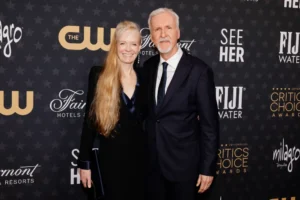The year’s most influential artists drove unprecedented crowds to museums, incited heated debates, spurred Instagram sensations, and set splashy auction records. Some harnessed innovative digital technologies, while others took centuries-old craft techniques to new heights. These artists reminded us of the spiritual power of art and the biases we keep; they shed light on the divisive times we live in and showed us the power of solidarity. The artists on this list—some household names, some relatively unheard-of, some inspiring us from the grave—represent a tiny fraction of the art we witnessed in 2019, though together, they give us a picture of the past 12 months, and a taste of what’s to come.
Kara Walker
B. 1969, Stockton, California. Lives and works in New York.
Kara Walker does not disappoint when it comes to major commissions, and her installation at Tate Modern’s Turbine Hall is no exception. Always transformative and urgent, Walker never hesitates to push and reinvent herself in order to arrive at the most prescient modes of expression. The Tate commission, titled Fons Americanus (2019), features a 40-foot-tall fountain that consumes the cavernous space. As Alina Cohen wrote for Artsy, Fons Americanus “reaffirms Walker’s position as one of the boldest, most ambitious artists working today—and acknowledges a fraught relationship between artist, spectacle, and viewer.”
Kara Walker
Kara Walker
View Slideshow
4 Images
The work, which is on view until April 5, 2020, references the horrors of the transatlantic slave trade and the legacy of racism it left behind. Walker imbued it with art-historical nods to such figures as Winslow Homer and Sandro Botticelli, while turning our guts with its ghastly, heartbreaking depictions. Many are comparing this to her mammoth 2014 installation A Subtlety or the Marvelous Sugar Baby at Brooklyn’s former Domino Sugar Factory. And, because there’s nothing she can’t do, a show of Walker’s films, organized by the brilliant Hilton Als, opened at Sprüth Magers in London during Frieze Week. Walker will have a solo show with her New York gallery Sikkema Jenkins in spring 2020.
Header images: Left: Portrait of Kara Walker by Ari Marcopoulos. Right: Installation view of Kara Walker’s Hyundai Commission, Fons Americanus, at the Tate Modern, London, 2019. © Kara Walker. Photo © Ben Fisher. Courtesy of Sikkema Jenkins & Co.
Olafur Eliasson
B. 1967, Copenhagen, Denmark. Lives and works in Copenhagen and Berlin.
During the 2019 UN Climate Action Summit, Olafur Eliasson was appointed as a United Nations Goodwill Ambassador. The Danish-Icelandic artist is renowned for his work concerning the environment, and in this newly created position, he will be an advocate for climate action and an ambassador to the UN’s Sustainable Development Goals. On top of this, Eliasson was busy this year mounting major exhibitions and new work around the world—plus, he starred in an episode of the Netflix series Abstract.
Olafur Eliasson
Olafur Eliasson
View Slideshow
5 Images
Eliasson’s blockbuster show at Tate Modern, titled “In real life,” opened in July and has averaged some 2,500 visitors per day. After it leaves the Tate in January 2020, the show will open at the Guggenheim Bilbao in February. Eliasson also held solo shows at the Tanks—the Tate’s satellite space—and at the Serralves Foundation in Porto, Portugal. All of this comes in addition to two new major public commissions unveiled this year: Seeing spheres (2019)at the Chase Center in San Francisco and Northwest Passage (2019) at MIT’s campus in Boston, both of which are permanent installations
Abu Hamdan / Cammock / Murillo / Shani
Founded 2019, United Kingdom.
In 2019, a single British artist did not win the Turner Prize. Ahead of the award ceremony, the shortlisted artists—Lawrence Abu Hamdan, Helen Cammock, Oscar Murillo, and Tai Shani—formed a collective, called Abu Hamdan / Cammock / Murillo / Shani. Together, they asked the judges not to pick one winner. “At this time of political crisis in Britain and much of the world,” the artists wrote in a letter, “when there is already so much that divides and isolates people and communities, we feel strongly motivated to use the occasion of the Prize to make a collective statement in the name of commonality, multiplicity and solidarity—in art as in society.” The jury unanimously agreed.
“Turner Prize 2019”
“Turner Prize 2019”
View Slideshow
6 Images
While some critics were exasperated by the move, others were supportive. The Guardian’s Adrian Searle wrote that “subverting the game is something artists are supposed to do.” Searle noted that in a similar spirit, Helen Marten shared her Turner winnings in 2016, following the lead of Theaster Gates, who split his 2015 Artes Mundi prize with fellow shortlisted artists. This latest, high-profile display throws into question the relevance of contemporary art prizes, suggesting that perhaps such funds and exposure should support many artists, rather than a chosen few. More importantly, it calls for a more united, empathetic art world.
Header images: Left: Tai Shani, installation view of DC Semiramis, 2019, at Turner Contemporary. Photo by Stephen White. Courtesy of the artist and Turner Contemporary. Right: Tai Shani, Lawrence Abu Hamdan, Helen Cammock, and Oscar Murillo. Photo by Stuart Wilson, via Getty Images.
Hilma af Klint
B. 1862, Stockholm, Sweden. D. 1944, Djursholm, Sweden.
In 2019, an exhibition of work by a reclusive, early 20th-century, Swedish female mystic broke attendance records at the Guggenheim. Over 600,000 visitors swarmed “Hilma af Klint: Paintings for the Future,” not just because of the artist’s unusual story, but because of her singular practice.
Hilma af Klint
Hilma af Klint
View Slideshow
5 Images
Before Wassily Kandinsky and his contemporaries “invented” abstraction, af Klint was making giant canvases that explored color, scale, and balance in brilliant new ways. One of the most celebrated works in the show, Group IV, The Ten Largest, No. 3, Youth (1907), features a bold tangerine background nearly bouncing with spiraling lines, wheels, ovals, and organic shapes in rainbow hues. Throughout af Klint’s work, feminine symbols and lush pastels abound.
The artist initially created these works to communicate with a higher power, envisioning their final home as a temple; Frank Lloyd Wright’s sloping, twisting exhibition space was an ideal locale. Though af Klint died in 1944, she remained relatively unknown until the Los Angeles County Museum of Art included her paintings in a 1986 group show. Audiences are hungry for art by previously underrecognized female artists, and the Guggenheim’s presentation—af Klint’s first comprehensive solo presentation in the United States—certainly delivered.
Header images: Left: Portrait of Hilma af Klint at the Royal Academy of Arts in Stockholm, ca. 1880. Courtesy of the Hilma af Klint Foundation. Right: Installation view of “Hilma af Klint: Paintings for the Future” at the Solomon R. Guggenheim Museum, New York. Photo by David Heald. © 2018 The Solomon R. Guggenheim Foundation.
Arthur Jafa
B. 1960, Tupelo, Mississippi. Lives and works in Los Angeles.
If the Venice Biennale is the art world’s Olympics, then Arthur Jafa took home a gold medal. He was awarded the Golden Lion—the biennale’s highest honor—for his film The White Album (2018). The piece was a highlight of the central exhibition, “May You Live in Interesting Times,” curated by Ralph Rugoff.
In an Artsy article from late 2018, writer Antwaun Sargent described the piece as a “roughly half-hour collage of appropriated music videos, CCTV and cellphone footage, viral clips, and documentary snippets—all edited into a kind of essay-film, to considerable narrative effect—[that] presents whiteness as the enfant terrible in a wild, mercurial collection of bad dreams about race and power.”
Arthur Jafa
Arthur Jafa
View Slideshow
5 Images
As Jafa explained in an interview with Sargent, the artist is “trying to make a more complex embodiment of my relationship to these things, as opposed to just saying something that’s true or false about whiteness. I’m not interested in true or false, I’m interested in: this is how I’m feeling in relationship to it.”
Many see the The White Album as the next step following Jafa’s 2016 video Love is the Message, the Message is Death: a work that artfully spliced together everything from black athletes at the heights of their powers to horrific acts of police brutality. The piece was recently featured at Turin’s Palazzo Madama and landed the artist the 2019 Prix International d’Art Contemporain, an $83,000 cash prize. Jafa also had a solo exhibition this year at Stockholm’s Moderna Museet, and 2020 will see another at Denmark’s Louisiana Museum of Modern Art.
Header images: Left: Arthur Jafa, installation view of The White Album, 2018. Photo by Francesco Galli. Right: Portrait of Arthur Jafa by Robert Hamacher. Courtesy of the artist and Gavin Brown’s Enterprise, New York / Rome.
Luchita Hurtado
B. 1920, Maiquetía, Venezuela. Lives and works in Los Angeles.
The 99-year-old Venezuelan painter Luchita Hurtado is proof positive that art-world success can come to those who wait, and 2019 was her belated breakout year. While she has been making work in earnest for decades, Hurtado’s professional résumé lists a single 1974 solo exhibition in Los Angeles prior to her overdue rediscovery in 2016, with a show at Park View/Paul Soto gallery. From there, the sky was the limit, with institutions and blue-chip galleries clamoring to belatedly catch up to the nonagenarian.
Luchita Hurtado
Luchita Hurtado
View Slideshow
5 Images
This year saw a wave of major career milestones for Hurtado. Hauser & Wirth (which announced representation of the artist late in 2018) staged an elegant survey in New York, “Dark Years,” featuring Hurtado’s early figurative and abstract works. And the Serpentine Galleries in London gave the artist her long-overdue U.K. debut—and her first institutional retrospective in Europe—with “I Live I Die I Will Be Reborn,” which paired older pieces with paintings that the artist had just completed. Lest anyone think Hurtado’s age is slowing her down, she’s still spry, charming, and avidly working out of her home in Santa Monica, California.
“Some of Hurtado’s most powerful works offer a vision of the human body as a part of the world, not separate from nature, while others focus on the language that we use to bridge the gap between ourselves and others,” said Serpentine curator Rebecca Lewin. “We’re only just beginning to appreciate how crucial this perspective is, and I have no doubt that it will continue to influence younger artists and audiences as more of her life’s work is seen and discovered.”
Header images: Left: Portrait of Luchita Hurtado by Oresti Tsonopoulos. © Luchita Hurtado. Courtesy of the artist and Hauser & Wirth. Right: Luchita Hurtado, Untitled, 1969. Photo by Jeff McLane. Courtesy of the Hammer Museum, Los Angeles and the Serpentine Galleries.
teamLab
Founded 2001, Tokyo. Based in Tokyo.
There may be no better case study of the present—and future—of contemporary art than the Tokyo-based collective teamLab, who, by 2019, have created a veritable empire. In August, news broke that the Japanese collective’s wildly popular museum at the Mori Building in Tokyo welcomed over 2 million visitors in its first year, becoming the most-visited museum devoted to a single artist. And in October, teamLab announced plans for two more spaces in Asia, in Shanghai and Macau.
teamLab
teamLab
View Slideshow
3 Images
The high-tech collective is at the vanguard of all things experiential, immersive, and spectacular, crafting believe-it-or-not installations that can make Yayoi Kusama’s “Infinity Mirror Rooms” look staid in comparison. TeamLab’s business savvy and penchant for ticketed events put their trippy, light-filled works somewhere on a continuum that would include the Rain Room (2012) and the Museum of Ice Cream—but their practice also connects with foundational moments in art history. “While digital means are new, the concept of experiential art is not,” said Pace executive vice president Peter Boris, who connects teamLab’s projects to artists of the Light and Space movement, like James Turrell, Robert Irwin, and Mary Corse. The collective’s approach is resolutely populist, though, engaging a broad public that may be allergic to traditional art institutions. “The meaning each of us gathers from that [teamLab] experience,” Boris added, “is our own, and as valid and correct as anyone else’s.”
While teamLab’s popularity as social-media backdrops is undeniable, the collective’s best installations are also marvels of technical ingenuity. Some, like The Sculpture of Time Distortion in a Mirror (2019), use simple materials—light and fog—to generate hallucinatory effects. Others incorporate smartphone apps to gamify the art experience, or touch-responsive orbs that create a kid-friendly, audiovisual wonderland.
Header images: Installation view of “Mori Building Digital Art Museum: teamLab Borderless,” 2018, Odaiba, Tokyo. © teamLab. Courtesy of Pace Gallery.
Sterling Ruby
B. 1972, Bitburg, Germany. Lives and works in Los Angeles.
Sterling Ruby vied for the title of Renaissance Man of the Year as he showed sculptures, paintings, ceramics, and a new fashion line across the U.S. and Europe. In February, Dallas’s Nasher Sculpture Center hosted a major presentation of Ruby’s mixed-media works—from giant ceramic basins to an outdoor stove to a giant cup dripping with blood-red urethane. That same month, in California, Ruby unveiled a gleaming red-orange sculpture in the Coachella Valley for Desert X; and opened a spooky show of skulls, fittingly titled “Damnation,” at Sprüth Magers in Los Angeles. The eerie heads, made from resin, urethane, fiberglass, aluminum, and yarn, featured sharp canine teeth, colorful eyeballs, and neon hair.
Sterling Ruby
Sterling Ruby
View Slideshow
5 Images
In June, Ruby debuted a clothing line, S.R. STUDIO. LA. CA, at Pitti Uomo in Florence, which earned rave reviews. Avant-garde offerings ranged from $595 T-shirts to unique $45,000 ponchos. The line was a bold move for Ruby, taking his long-standing engagement with fashion to the next level, while also expanding his oeuvre—and market—as an artist.
During Frieze London in October, Gagosian’s fair booth featured Ruby’s sunny new paintings, while its Britannia Street gallery housed his “ACTS,” giant Formica plinths that hold clear urethane prisms with colored dye swirling within. (Ruby is also represented by Xavier Hufkens in Brussels.) Ruby closes 2019 with a bang with his first-ever museum retrospective, which opened in November at ICA Miami and was a major attraction during Art Basel in Miami Beach. The show will travel to ICA Boston in February 2020.
Header images: Left: Sterling Ruby, SPECTER, 2019 AT DESERT X, Coachella Valley, CA. © Sterling Ruby. Photo by Lance Gerber. Right: Portrait of Sterling Ruby by Bennet Perez.
Yoshitomo Nara
B. 1959, Hirosaki, Japan. Lives and works in Tochigi, Japan.
In terms of sheer art-market force, few artists this year were on the same level as Yoshitomo Nara, the Caravaggio of kawaii. In the month of October alone, his work appeared at auction 63 times. Some lots, like limited-edition merch—including toys, plates, and a portable radio—sold in the low quadruple digits. Meanwhile, his enormous painting Knife Behind Back (2000) eclipsed its pre-sale estimate of $6.4 million to sell for a whopping $24.9 million at a Sotheby’s auction in Hong Kong. That result more than quintupled Nara’s previous auction record, $4.4 million, which was set earlier this year at a Christie’s auction in May.
Yoshitomo Nara
Yoshitomo Nara
View Slideshow
4 Images
Beyond auction house salesrooms, Nara was no slouch this year. He presented a solo show at the Château la Coste in the South of France and a year-long project at the Japan Society in New York. But the show of institutional support that may have given his market a shot in the arm was the news that the Los Angeles County Museum of Art is planning a 30-year survey of Nara’s work, slated to open in April 2020.
Header images: Left: Portrait of Yoshitomo Nara. Photo by Franke Tsang / South China Morning Post via Getty Images. Right: Installation view of Yoshitomo Nara, Knife Behind Back, 2000. Courtesy of Sotheby’s.
















+ There are no comments
Add yours